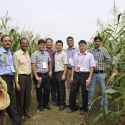29 Jun 2015
Geostatistical approach for management of soil nutrients with special emphasis on different forms of potassium considering their spatial variation in intensive cropping system of West Bengal, India
A large part of precision agriculture research in the developing countries is devoted towards precision nutrient management aspects. This has led to better economics and efficiency of nutrient use with off-farm advantages of environmental security. The keystone of precision nutrient management is analysis and interpretation of spatial variability of soils by establishing management zones. In this study, spatial variability of major soil nutrient contents was evaluated in the Ghoragacha village of North 24 Parganas district of West Bengal, India. Surface soil samples from 100 locations, covering different cropping systems of the village, was collected from 0 to 15 cm depth using 100×100 m grid system and analyzed in the laboratory to determine organic carbon (OC), available nitrogen (N), phosphorus (P), and potassium (K) contents of the soil as well as its water-soluble K (KWS), exchangeable K (KEX), and non-exchangeable forms of K (KNEX). Geostatistical analyses were performed to determine the spatial variation structure of each nutrient content within the village, followed by the generation of surface maps through kriging. Four commonly used semivariogram models, i.e., spherical, exponential, Gaussian, and linear models were fitted to each soil property, and the best one was used to prepare surface maps through krigging. Spherical model was found the best for available N and P contents, while linear and exponential model was the best for OC and available K, and for KWS and KNEK, Gausian model was the best. Surface maps of nutrient contents showed that N content (129–195 kg ha−1) was the most limiting factor throughout the village, while P status was generally very high ( 10–678 kg ha−1) in the soils of the present village. Among the different soil K fractions, KWS registered the maximum variability (CV 75 %), while the remaining soil K fractions showed moderate to high variation. Interestingly, KNEX content also showed high variability, which essentially indicates reserve native K exploitation under intensive cultivation. These maps highlight the necessity of estimating the other soil K fractions as well for better understanding of soil K supplying capacity and K fertilization strategy rather than the current recommendations, based on the plant available K alone. In conclusion, the present study revealed that the variability of nutrient distribution was a consequence of complex interactions between the cropping system, nutrient application rates, and the native soil characteristics, and such interactions could be utilized to develop the nutrient management strategies for intensive smallholder system.

